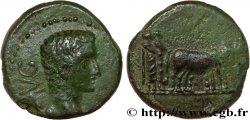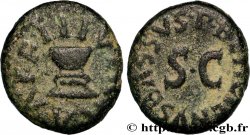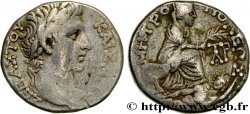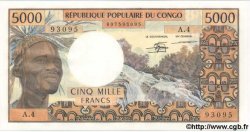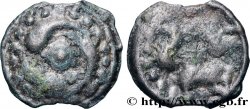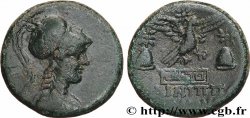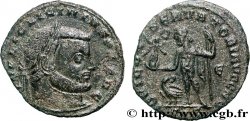bpv_141557 - AUGUSTUS Tétradrachme syro-phénicien
недоступный.
Товар уже продан в нашем интернет-магазине
Цена: : 170.00 €
Товар уже продан в нашем интернет-магазине
Цена: : 170.00 €
Тип Tétradrachme syro-phénicien
Дата: An 36 et 13e consulat
Монетный двор / Город: Antioche, Syrie, Séleucie et Piérie
Металл: silver
Диаметр: 26 mm
Ориентация осей монеты: 12 h.
Вес: 14,06 g.
Комментарии о состоянии
Exemplaire à l’usure importante, mais complètement lisible et identifiable, style et frappe standards pour l’emission
Ссылки в каталоге: :
Лицевая сторона
Аверс: описание: Tête laurée d’Auguste à droite entouré de la stemma (O*).
Аверс: легенда: KAISAROS SE-BASTOU (Kaisaros Sebastou)
Аверс: перевод: (César Auguste).
Обратная сторона
Реверс: Описание: Tyché (Ville d’Antioche) tourelée, voilée et drapée assise à droite sur un rocher, tenant une palme de la main droite ; à ses pieds à droite, l’Oronte nageant à droite.
Реверс: легенда: ANTIOCEWN MHTROPOLEWS - sL - DN
Реверс: перевод: Antioche métropole / monogramme d’Antioche - 36 - 54.
Комментарий
Cette émission, qui s’étend de l’an 36 (6 AD) à la mort de l’Empereur, en l’an 44 du règne (14 AD) présente aussi un type religieux plus oecuménique que ceux qu’utilisèrent les Séleucides : la Tyché de la ville d’Antioche. On peut penser que l’Antioche de l’époque, probablement une ville de 150 à 200.000 habitants, était un creuset de cultes différents et que les Romains, plutôt que d’imposer un dieu particulier, choisirent une image dans laquelle tous les Antiochéens, voire tous les habitants de la région, pouvaient se reconnaître. La statue de la Tyché représentée au revers, était la statue cultuelle de l’artiste Eutychides, si célèbre que des copies d’époque nous en sont parvenues.
En revanche, cette variante se caractérise par une légende qui fait directement référence à la ville l’Antioche, appelée ici Métropole, titre essentiel dans la hiérarchie des villes grecques, et par une datation simultanée en années régnales, ici la trente-sixième année du règne et par l’année de l’ère césarienne (qui débute à sa première visite dans la région), ici cinquante-quatrième année.
Dans la base TSP maintenue par Michel Prieur, soixante-dix exemplaires sont maintenant répertoriés, cet exemplaire est le 0057_046.
This issue, which extends from the year 36 (6 AD) to the death of the Emperor, in the year 44 of the reign (14 AD) also presents a more ecumenical religious type than those used by the Seleucids: the Tyche of the city of Antioch. It is possible to think that Antioch at that time, probably a city of 150 to 200. 000 inhabitants, was a melting pot of different cults and that the Romans, rather than imposing a particular god, chose an image in which all the Antiochians, indeed all the inhabitants of the region, could recognize themselves. The statue of Tyche depicted on the reverse was the cult statue of the artist Eutychides, so famous that examples of it from the period have come down to us..
On the other hand, this variant is characterized by a legend that directly refers to the city of Antioch, called here Metropolis, an essential title in the hierarchy of Greek cities, and by a simultaneous dating in regnal years, here the thirty-sixth year of the reign and by the year of the Caesarean era (which begins with his first visit to the region), here the fifty-fourth year.
In the TSP database maintained by Michel Prieur, seventy examples are now listed, this example is 0057_046
En revanche, cette variante se caractérise par une légende qui fait directement référence à la ville l’Antioche, appelée ici Métropole, titre essentiel dans la hiérarchie des villes grecques, et par une datation simultanée en années régnales, ici la trente-sixième année du règne et par l’année de l’ère césarienne (qui débute à sa première visite dans la région), ici cinquante-quatrième année.
Dans la base TSP maintenue par Michel Prieur, soixante-dix exemplaires sont maintenant répertoriés, cet exemplaire est le 0057_046.
This issue, which extends from the year 36 (6 AD) to the death of the Emperor, in the year 44 of the reign (14 AD) also presents a more ecumenical religious type than those used by the Seleucids: the Tyche of the city of Antioch. It is possible to think that Antioch at that time, probably a city of 150 to 200. 000 inhabitants, was a melting pot of different cults and that the Romans, rather than imposing a particular god, chose an image in which all the Antiochians, indeed all the inhabitants of the region, could recognize themselves. The statue of Tyche depicted on the reverse was the cult statue of the artist Eutychides, so famous that examples of it from the period have come down to us..
On the other hand, this variant is characterized by a legend that directly refers to the city of Antioch, called here Metropolis, an essential title in the hierarchy of Greek cities, and by a simultaneous dating in regnal years, here the thirty-sixth year of the reign and by the year of the Caesarean era (which begins with his first visit to the region), here the fifty-fourth year.
In the TSP database maintained by Michel Prieur, seventy examples are now listed, this example is 0057_046







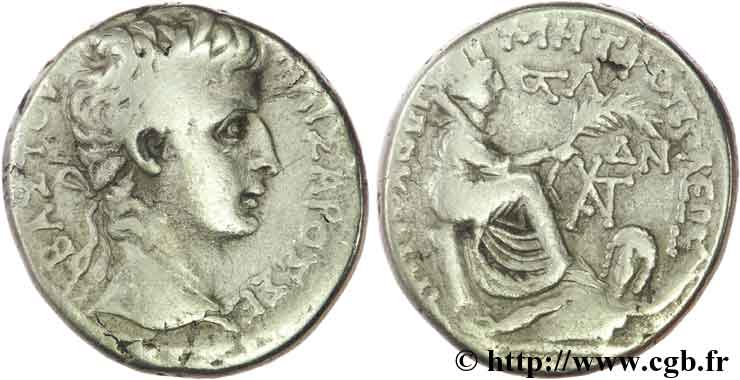
 Cообщить об ошибке
Cообщить об ошибке Распечатать страницу
Распечатать страницу Отправить мой выбор
Отправить мой выбор Задать вопрос
Задать вопрос Consign / sell
Consign / sell
 Информация
Информация
